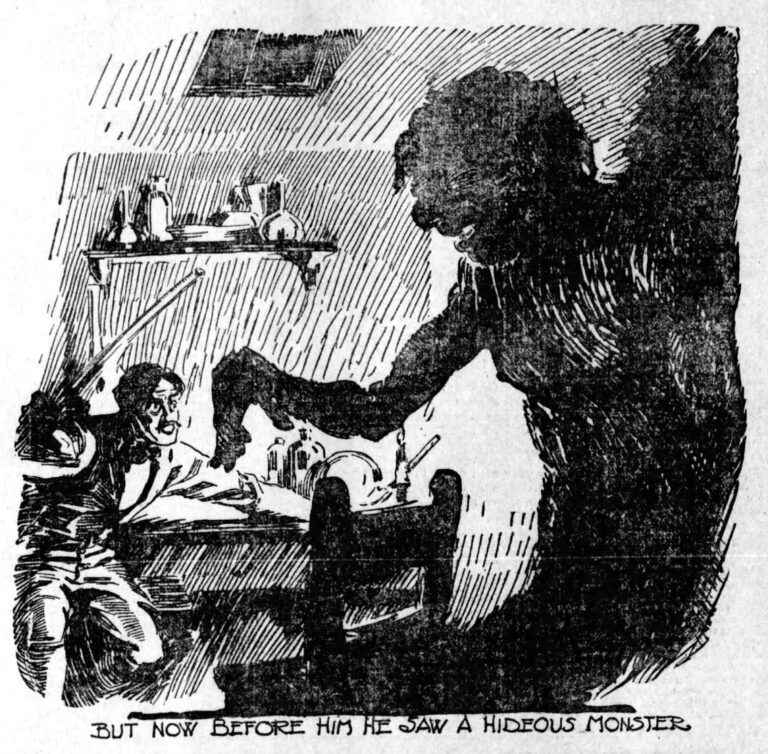The mad scientist was in his castle or his dungeon or his lab, wherever he chose to conduct his experiments. Wind roared. Lightning flashed. And out of the dark came something that would horrify even the most hardened of men…
But what – or who?
It’s no secret that the stereotypical view of a scientist is a man, usually white, usually old. It’s what we’ve grown accustomed to seeing on our screens. So what do you do when you’re interested in science and you’re not an old white guy?
Why, you build a monster, of course!

There is an expectation for people who do not fit into the “ideal” of a scientist to bend and break until they’re the square peg in the round hole.
For some of us, this means changing the language we use, dressing differently, and ignoring comments in the name of banter when they sit uncomfortably on our skin. It’s leaving parts of ourselves behind and forcing ourselves to act in ways that feel wrong. It’s twisting ourselves into shapes that stop feeling comfortable in the name of professionalism.
It’s rebuilding ourselves into something palatable. But what is lost in the rebuilding? And what if we become the monsters of myth?
In 1818 Mary Shelley wrote the first science fiction novel, Frankenstein. The night she told the tale has slipped into literary legend, with some of the greatest writers of their time locked away in a house attempting to tell the scariest ghost story. Only, in the telling of Frankenstein, of mixing scientific possibility with literature, Shelley stumbled upon something else; a metaphor that echoes through time for anyone who does not fit the mould.
Hidden Identities
Even more recently, it’s been pointed out that people of colour have also been underrepresented in science. In Australia, the incorporation of Indigenous knowledge and co-creation of science is the latest area of science communication research.
Most recently, the integration of queer knowledge and ways of being has also been considered in science communication. This area is still very much in development, although if my preliminary research is anything to go by, science is still resistant to visible queerness.
For those of us who aren’t old or white or men, for those of us whose identities don’t align with this perception of a “proper” scientist, we do what we can to fit in. We remove our femininity. We hide our queerness. We act white. No one will notice we’re different if we play by their rules.
Only you can’t remove your womanhood, your queerness, your race. It’s always there, lurking beneath the surface.
And it’s always waiting to be released.
We make ourselves anew, taking bits and pieces and building an identity that fits within the world of science. And when those who demand we do this look upon us, they feel a sense of uneasiness. They know something is wrong, that we still don’t fit. We become, as Viktor Frankenstein says upon seeing his creature, “the miserable monster whom [they] had created.”
We play Viktor Frankenstein until we become the monster.
But is it our fault? We do as they ask and change our identity, building ourselves out of the scraps that we are given. We assemble into something more than the parts of our whole. A new identity and a yearning for acceptance.
But then, is it not the fault of science that we have become this?

In our attempts to build ourselves into something that will be accepted into science, we have become something hideous. An amalgamation of identities that are not our own and never quite fit right. We are cast with suspicion and held to higher standards. We suffer from imposter syndrome, and when we call out injustices we’re brushed aside.
In a system that is built for our antithesis, how can we thrive?
Perhaps what’s needed can be found in Frankenstein, the blueprint for what we do to ourselves.
Viktor, in pursuit of his monster, says, “I felt what the duties of a creator towards his creature were, and that I ought to render him happy before I complained of his wickedness.”
Perhaps the answer is in allowing us to cast off identities that do not fit, and allow us to wander free in our own skin. Perhaps the answer is in shouting as loudly as we can so everyone can see who we are. And perhaps, ultimately, the answer is in kindness.



All opinions on this website are representative of individuals and are not representative of The University of Western Australia. The University of Western Australia is not liable for content herein.
1 Comment
[…] Read more from our Blog; […]